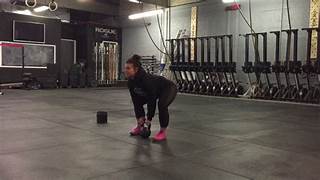
Exercise We Love: The Kettlebell Goblet Clean.
The kettlebell goblet clean is a powerful, full-body movement that blends strength, explosiveness, and control into one fluid lift. Ideal for all fitness levels, it improves posture, enhances coordination, and builds functional strength using just a single kettlebell. Whether used in strength circuits, warm-ups, or conditioning workouts, this versatile exercise delivers big results in minimal time, making it a must-have in any training program.
💪 Fitness Guru
53 min read · 20, Jun 2025

Introduction
The fitness world is no stranger to innovation and reinvention. But among the myriad of trendy workouts and equipment, some exercises stand the test of time—effective, efficient, and enduring. One such gem is the Kettlebell Goblet Clean. This dynamic, multi-functional movement is not just about looking good in the gym; it’s a functional powerhouse that offers full-body engagement, builds strength, enhances coordination, and develops explosive power.
Whether you're a beginner trying to dip your toes into kettlebell training or an advanced athlete looking to refine your form and intensity, the kettlebell goblet clean deserves a place in your workout arsenal.
What is the Kettlebell Goblet Clean?
The Kettlebell Goblet Clean is a hybrid strength and conditioning movement where a kettlebell is pulled from the floor or between the legs and "cleaned" into a goblet position (held upright close to the chest). The movement combines a hip hinge similar to a deadlift or swing, and a clean motion that brings the weight into the front rack position.
Unlike the traditional barbell clean, which can be intimidating due to technical complexity and required mobility, the goblet clean with a kettlebell simplifies the motion without compromising on effectiveness.
Muscles Worked
The Kettlebell Goblet Clean is a compound exercise, engaging multiple muscle groups:
- Glutes and Hamstrings – from the explosive hip hinge.
- Quadriceps – during the pulling and squatting phase.
- Core (Abs and Obliques) – for stabilization.
- Shoulders and Upper Back – to assist with the clean.
- Biceps and Forearms – as secondary stabilizers.
- Trapezius and Rhomboids – in maintaining posture.
This full-body engagement makes it excellent for both strength development and fat-burning workouts.
Benefits of the Kettlebell Goblet Clean
1. Functional Strength
This movement mimics real-life lifting patterns, such as picking up a child or loading a bag into the car. It builds strength that translates into everyday activities.
2. Cardiovascular Conditioning
When performed for repetitions or as part of a circuit, the kettlebell goblet clean can elevate heart rate quickly, providing a cardio stimulus while building strength.
3. Improved Posture and Core Stability
The front-loaded nature of the exercise demands strong postural muscles and a tight core, leading to improved spinal alignment and balance.
4. Explosive Power
The explosive hip extension involved in the clean is essential for athletes who need jumping or sprinting power.
5. Accessibility
Beginners often find the goblet position easier to control than barbell front-racks, making this a great entry point into Olympic-style lifting.
Proper Form and Technique
Let’s break down how to correctly perform the Kettlebell Goblet Clean step-by-step:
Step-by-Step Instructions
- Start Position:
- Stand with feet shoulder-width apart.
- Place the kettlebell between your feet.
- Hinge at the hips and slightly bend your knees to grasp the kettlebell with both hands (palms facing you).
- The Hike:
- Pull the kettlebell slightly back between your legs to initiate a hip hinge.
- Keep your back flat and core tight.
- The Pull:
- Drive through your heels, thrust your hips forward explosively to generate momentum.
- As the kettlebell begins to rise, pull it upward with your arms staying close to your body.
- The Catch:
- As the kettlebell reaches chest height, tuck your elbows under and catch it in the goblet position (kettlebell at chest level, elbows pointing downward).
- Avoid flipping or slamming the bell—aim for a smooth, controlled catch.
- Reset or Transition:
- Either lower the kettlebell to repeat the movement, or transition into another exercise (like a goblet squat or press).
Common Mistakes and How to Fix Them
1. Using the Arms Too Much
Mistake: Relying on your arms to pull the kettlebell up instead of using hip drive.
Fix: Focus on explosive hip thrusts, not arm curls.
2. Letting the Kettlebell Slam
Mistake: The bell crashes into your chest.
Fix: Keep the movement close to the body and practice "guiding" it into position rather than letting it swing.
3. Poor Posture
Mistake: Rounding the back during the pick-up or catch.
Fix: Engage your core and lats, and keep your spine neutral throughout.
4. Inconsistent Breathing
Mistake: Holding your breath.
Fix: Inhale during the hinge, exhale during the pull/catch.
Progressions and Variations
The kettlebell goblet clean can be adapted for various skill levels:
1. Double Kettlebell Clean
Use two kettlebells for increased load and bilateral coordination.
2. Clean to Squat
Combine with a goblet squat for a full-body metabolic movement.
3. Clean to Press
Add an overhead press after the clean for an upper-body challenge.
4. Clean to Reverse Lunge
Incorporate a reverse lunge to train unilateral lower-body strength and balance.
Sample Workout Incorporating the Goblet Clean
Full-Body Kettlebell Circuit (Repeat 3-5 Rounds)
- Goblet Clean – 10 reps
- Goblet Squat – 10 reps
- Kettlebell Swings – 15 reps
- Clean to Press – 6 reps
- Plank Hold – 30 seconds
- Rest – 60-90 seconds
This routine targets strength, power, endurance, and core stability all in one go.
Tips for Safe and Effective Practice
- Start light: Focus on form before loading heavy.
- Warm up properly: Mobilize hips, shoulders, and wrists.
- Use a quality kettlebell: A proper handle and grip help prevent injury.
- Film yourself: To check technique or work with a coach for feedback.
The Kettlebell Goblet Clean is a remarkable full-body exercise that fuses strength, coordination, and conditioning into one seamless motion, earning its place among the most effective and accessible functional training movements available today. At its core, this exercise involves pulling a kettlebell from a starting position—often from between the legs or from the ground—into the goblet position, which means holding the bell upright close to the chest with both hands. While simple in appearance, this movement demands precise coordination between the lower and upper body, utilizing a powerful hip hinge to generate momentum and a controlled arm motion to guide the kettlebell smoothly into place without letting it crash into the chest. What sets the goblet clean apart from its barbell or single-arm kettlebell counterparts is its user-friendly form and adaptability, making it an excellent entry point for beginners while still offering advanced practitioners the opportunity to refine their explosive power, grip strength, and postural control. The movement primarily targets the glutes, hamstrings, and quadriceps, driven by the explosive hip extension required to elevate the kettlebell, but it also heavily engages the core to stabilize the body during the transition phase and requires significant input from the shoulders, upper back, and forearms to complete the catch in a smooth, controlled manner. Unlike isolated strength exercises, the goblet clean excels at simulating real-life movement patterns, such as lifting groceries from the floor or picking up a child, which enhances functional strength that translates to day-to-day activities. Moreover, when performed in multiple repetitions or integrated into a metabolic circuit, it provides a powerful cardiovascular stimulus that raises the heart rate, burns fat, and boosts endurance without needing a treadmill or elliptical. It also demands postural awareness, as the front-loaded kettlebell encourages an upright spine, activated core, and retracted shoulder blades, which helps correct and improve posture over time. The versatility of the goblet clean is also noteworthy—it can stand alone as a strength movement, be used to transition into other exercises such as squats or presses, or be incorporated into high-intensity interval training for a heart-pumping, fat-burning session. Its learning curve is far more forgiving than that of the barbell clean, which typically requires weeks of coaching to avoid technical breakdowns, making it perfect for those new to explosive lifting techniques. However, despite its accessibility, the goblet clean is by no means a beginner-only move; experienced lifters use it to hone in on mechanics, warm up for more complex lifts, or add intensity to conditioning workouts. That said, mastering the technique is essential—many novices make the mistake of pulling with the arms instead of driving with the hips, resulting in inefficient and awkward movement patterns, or worse, discomfort and injury. A successful goblet clean requires the practitioner to generate force from the ground up, thrusting through the hips to propel the kettlebell upward while keeping the arms relaxed and close to the body to avoid letting the weight swing out, which often leads to it slamming into the chest. Instead, the lifter should "zip up" the kettlebell along the torso and catch it with elbows pointing downward in the goblet position, letting the kettlebell rotate gently into place. Attention must also be paid to the spine—maintaining a neutral back and bracing the core prevents rounding during the hinge and stabilizes the body throughout the movement. Once the kettlebell is caught in the goblet position, it serves as a gateway to additional movements such as squats, lunges, or presses, creating endless workout combinations with just one piece of equipment. Variations of the goblet clean further expand its utility; for instance, pairing it with a squat creates a time-efficient full-body combo, while performing alternating cleans with two kettlebells introduces balance and coordination challenges. Even more advanced variations such as the clean-to-press or clean-to-reverse-lunge push the body into new planes of motion, activating more muscle fibers and elevating the metabolic demand. In addition to its physical benefits, the goblet clean also serves as a neurological builder—it improves timing, rhythm, and body awareness, especially when performed for higher reps or under fatigue. For those building home gyms or looking for minimalist workout options, the kettlebell goblet clean is a no-brainer; it requires minimal space, just one well-chosen kettlebell, and delivers a comprehensive workout in just a few minutes. A good starting point for most men would be a kettlebell between 12–16 kg (26–35 lbs), while women typically benefit from 8–12 kg (18–26 lbs), but individual strength levels and movement proficiency should guide the choice. In programming, the goblet clean can be used during warmups to activate the posterior chain, as a strength-building set performed with low reps and longer rests, or as a metabolic finisher when used in circuits of 10–15 repetitions. Breathing also plays a role—inhaling during the hinge and exhaling during the catch helps stabilize the core and maintain rhythm. While the goblet clean is generally safe, individuals with lower back issues or shoulder limitations should consult a professional trainer or physical therapist before diving in, as incorrect form can exacerbate these conditions. Ultimately, what makes the Kettlebell Goblet Clean so beloved among coaches and athletes alike is its rare combination of simplicity and effectiveness—it teaches explosive power, improves coordination, strengthens posture, and burns fat, all while reinforcing fundamental movement patterns essential to both athletic performance and daily life. In a world where time, equipment, and energy are often in short supply, this one move provides a compact, high-return solution for nearly every fitness goal.
Among the vast array of strength and conditioning exercises available to fitness enthusiasts and athletes alike, the kettlebell goblet clean stands out as a uniquely powerful, efficient, and accessible movement that provides a comprehensive workout for the entire body while also promoting functional movement patterns, enhanced coordination, and cardiovascular conditioning, making it a favorite among personal trainers, physical therapists, and home gym users worldwide; at its essence, the kettlebell goblet clean is a compound lift that combines the explosive hip drive of a kettlebell swing or deadlift with the fluid, controlled motion of a clean that culminates in the kettlebell being caught in the goblet position at chest height, held close to the body with the elbows pointing downward and the forearms vertical, creating a stable and compact load distribution that challenges the anterior chain and core while also developing grip strength and shoulder stability, and while it may appear simple on the surface, the goblet clean is an intricate blend of power, timing, and technique that requires practice, body awareness, and an understanding of fundamental movement mechanics such as the hip hinge, bracing of the core, and scapular retraction, all of which are essential not only for executing the clean properly but also for preventing injury and building a foundation for more advanced lifts; the exercise starts with the lifter standing with feet shoulder-width apart, a kettlebell placed between the feet, and both hands gripping the handle with thumbs facing inward, after which the lifter initiates the movement by hiking the kettlebell slightly backward between the legs in a hinge position, maintaining a flat back and tight core, and then drives forcefully through the heels, extending the hips and generating upward momentum through the posterior chain—primarily the glutes and hamstrings—before guiding the kettlebell up the midline of the body with the elbows tucked in, culminating in a seamless catch at the chest where the kettlebell is momentarily held before being lowered back into the starting position or transitioned into another movement like a squat, press, or lunge, making it an incredibly versatile and modular exercise that fits easily into circuits, strength routines, warm-ups, or finishers; the muscles worked during this motion include the entire posterior chain—glutes, hamstrings, and spinal erectors—as well as the quadriceps, calves, core, deltoids, trapezius, biceps, and forearms, making it one of the most efficient compound exercises available, especially for those with limited time or equipment; what’s more, the goblet clean requires very little space and just a single kettlebell, meaning that it can be performed virtually anywhere, from the gym floor to a living room, making it ideal for home workouts, travel routines, and those seeking minimalist strength programs; beyond its utility and effectiveness, the goblet clean offers significant benefits in terms of athletic performance, as the hip explosion and timing required mirror the biomechanics of sprinting, jumping, and rapid change of direction, while the front-loaded position enhances core engagement and encourages good posture by reinforcing thoracic extension and scapular stability, which are crucial for anyone who spends long hours sitting or working at a desk; for beginners, the goblet clean serves as an accessible entry point into the world of dynamic lifting, offering a less intimidating alternative to barbell cleans and Olympic lifting movements, yet still teaching the principles of explosive power generation, load control, and breathing coordination, and for advanced lifters, it provides a valuable opportunity to reinforce foundational skills, refine timing and bar path, and add variety to strength training sessions without the need for excessive weight or specialized equipment; in fact, because the goblet clean emphasizes quality of movement over brute strength, it naturally encourages mindfulness and attention to technique, which not only reduces the risk of injury but also fosters a deeper mind-muscle connection and awareness of how the body moves through space—an essential trait for long-term fitness success and injury prevention; the goblet clean also scales well with progression—beginners might start with light kettlebells and focus on slow, deliberate movement, while intermediate and advanced lifters can increase the weight, perform the clean with added time under tension, or incorporate it into high-intensity circuits or complexes that include goblet squats, clean-and-presses, or lunge variations for full-body engagement and metabolic conditioning; common mistakes to watch for include relying too much on the arms to lift the kettlebell instead of generating force from the hips, allowing the kettlebell to crash into the chest instead of catching it softly with control, rounding the back during the hinge phase, or failing to maintain core tension throughout the movement, all of which can reduce the effectiveness of the exercise or increase the risk of injury, which is why it's often recommended to practice the movement slowly at first, record oneself on video, or work with a qualified coach to ensure proper mechanics; breathing is another key component of mastering the kettlebell goblet clean, as synchronizing breath with movement—typically inhaling during the downward phase and exhaling during the upward pull—helps brace the core, stabilize the spine, and maintain rhythm, particularly when the exercise is performed for high reps or under fatigue; unlike exercises that isolate a single muscle group, the goblet clean integrates the entire kinetic chain and promotes real-world strength, making it not only effective for physique goals like building muscle and burning fat but also for improving how you move and feel in everyday life, whether you’re lifting groceries, playing with your kids, or engaging in recreational sports; the beauty of the goblet clean lies in its simplicity and scalability—once you’ve nailed the form, you can string multiple reps together in a flow, pair it with other movements in supersets, or even include it in timed intervals for a cardio-strength hybrid workout that leaves you breathless and pumped in just minutes; in terms of equipment, most people can begin with a kettlebell weighing between 8 to 16 kilograms (18 to 35 pounds), depending on their experience, strength level, and movement proficiency, and gradually increase the load as their technique and confidence improve; from a programming standpoint, the goblet clean can be performed two to three times per week for general fitness, integrated into full-body circuits, or used as a dynamic warm-up to prime the nervous system and activate key muscle groups before heavier lifts; ultimately, the kettlebell goblet clean is one of those rare exercises that checks every box—it builds strength, develops power, improves conditioning, reinforces good posture, teaches body control, and does it all with a single compact tool that fits in a corner of your living room, making it not just an exercise we love, but one that every lifter—regardless of their age, goal, or experience—should consider mastering for a lifetime of strength, mobility, and confidence.
Conclusion
In the ever-evolving fitness landscape, the Kettlebell Goblet Clean stands out for its functional value, safety, and effectiveness. With minimal equipment, you can achieve maximal results. It teaches coordination, balance, control, and raw power—all packaged in a single fluid motion. Whether you’re doing it as a standalone move or combining it with squats and presses, it’s a tool you’ll keep coming back to.
Don’t underestimate the simplicity of this exercise—mastering the goblet clean could be one of the most impactful steps in your fitness journey.
Q&A Section
Q1: What is the difference between a goblet clean and a traditional kettlebell clean?
Ans: The goblet clean is done with both hands and brings the kettlebell into a goblet position at the chest, while a traditional kettlebell clean is usually done single-handed into a rack position. The goblet clean is easier for beginners and offers more control.
Q2: Can I do the goblet clean every day?
Ans: While it’s safe when done with proper form, it's best to allow at least 48 hours between intense sessions for muscle recovery. Frequency should match your training goals and overall program.
Q3: What weight should I start with?
Ans: Beginners should start with a light-to-moderate kettlebell—typically 8–12 kg (18–26 lbs) for women and 12–16 kg (26–35 lbs) for men, depending on individual strength and experience.
Q4: How many reps and sets should I do?
Ans: For strength, aim for 3–5 sets of 5–8 reps. For conditioning, try higher reps (10–15) in circuits. Always prioritize form over quantity.
Q5: Is the goblet clean safe for people with back problems?
Ans: It can be safe if done with proper form and under professional supervision, as it emphasizes hip hinging and core activation. However, those with back issues should consult a physical therapist or trainer before attempting it.
Similar Articles
Find more relatable content in similar Articles

Parenting and Fitness: Turning Playtime Into Workouts...
Discover how parents can seaml.. Read More

The Skin-Food Connection: What to Eat for Acne-Free, Radiant..
What you eat directly shapes .. Read More

Anti-Aging on a Plate: Foods That Keep Your Skin Youthful an..
What you eat reflects on your.. Read More

Training with Altitude Masks: Does It Really Mimic Mountain ..
Exploring Altitude Masks: Sepa.. Read More
© 2024 Copyrights by rFitness. All Rights Reserved.